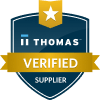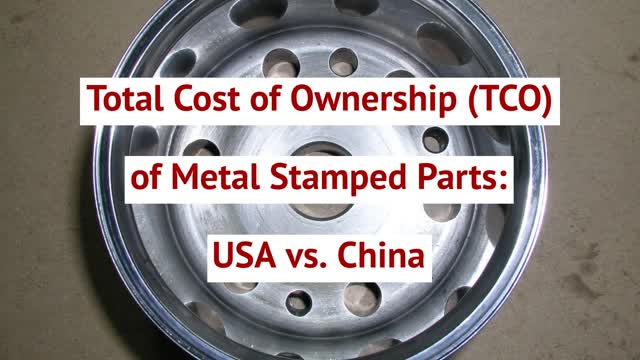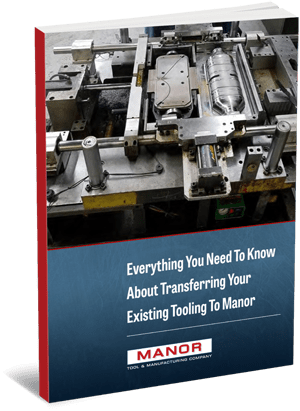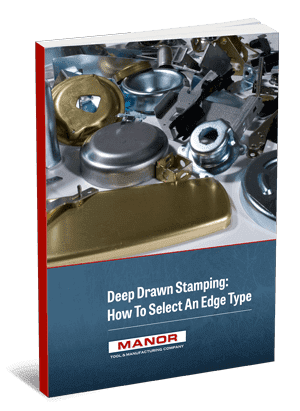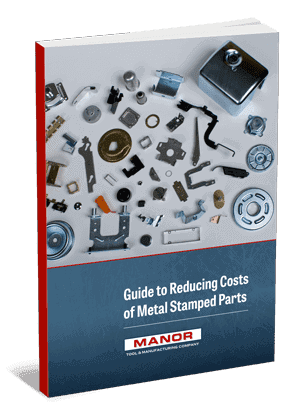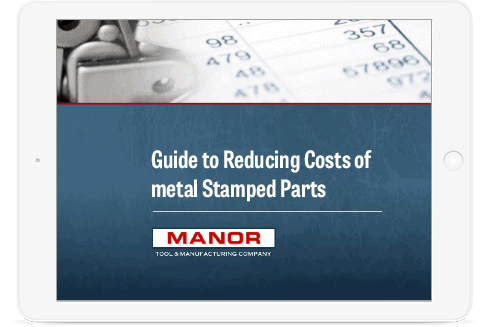Total Cost of Ownership (TCO) of Metal Stamped Parts: USA vs. China
Many companies became enamored with offshoring the manufacturing of their parts to China due to the appearance of lower per-part-costs. Unfortunately this approach to production has many hidden costs that drive up the total cost of ownership (TCO) of your metal stamped parts. When answering the question “how much does metal stamping cost for our parts”, you need to take five factors into account.
Tooling & Die Quality
To produce quality metal stamped parts successfully at high volume, it all starts with the tooling and die used in the process. This is the most critical component. There is a wide gap between the quality and durability of tool steel used in dies manufactured in the USA vs those made in China. Dies designed and manufactured by Manor Tool are guaranteed to perform 1,000,000+ strikes prior to any maintenance required to maintain part quality. This is due to the very slow wear on the tool steel and mechanical travel of the die. Dies made of lower quality in the Far East wear out much faster and in turn introduce flaws in components much more quickly. This means down time to repair and maintain the die. When your die is offline you aren’t making parts – and when you aren’t making parts you aren’t meeting orders or driving revenue for your business. Any potential savings a business thought they were receiving by having tooling produced in China is quickly lost (and then some) when low quality dies derail your production.
Production Troubleshooting
Partnering with a supplier that is very far from your main facility makes troubleshooting production issues far more complex. Simply connecting to discuss the issue can be a challenge in and of itself. Due to the massive difference in time zones working hours do not overlap. For example, a part outsourced to Guangzhou, China by a company in Chicago, IL would have a 13 hour time difference. So just as your team is coming into the office at 7:30am in Chicago, your production team will be asleep at 11:30pm in China. When you do work out the time for a meeting to discuss an issue, there are typically language barriers as only a few individuals on staff will speak english. This means all of your feedback needs to get communicated second hand, introducing more room for error. In the event of a severe production issue that requires onsite correction, you and the team are multiple days out from reaching your outsourced production facility – assuming all of your travel paperwork is ready and in order to visit China. All of this takes time. That time costs you money in lost production time, poor part quality that ends up headed for the scrap bin, and the expense of a rerun to try and meet the customer order timeline impacted by the quality issue. Partnering with a domestic supplier makes it easier to communicate and collaborate when there are issues, reducing your TCO for your metal stamped parts.
Shipping Costs
Producing metal stamped parts in China introduces the need for very long shipping distances. Due to the additional logistics required to get your parts from China to the USA, there are several other potential negative impacts to consider when calculating the overall total price of your metal stamped parts. You will need to decide how best to ship your products based on volume and weight. While there may be potential for air freight on smaller volume or lower weight components, you will most likely have to contract with a shipping company to deliver your components. This means getting them from the factory, to the port, loaded into a shipping container, placed on a ship across the ocean, unloaded from the vessel, checked by customs, and loaded onto a truck for delivery. All of these steps can have challenges. The price of shipping containers quadrupled in 2020 causing costs to skyrocket for overseas parts. Ports were congested and delayed throughout the pandemic causing months-long impact to typical lead times. This means lead times can vary wildly based due to these factors, resulting in an increased overall cost of your parts made in China. Tariffs were introduced on some goods causing confusion and increased prices on impacted products and components being imported from China. The added complexity of long distance logistics in the manufacturing of your metal stamped parts for your business means a more fragile supply chain that will cause havoc with your bottom line..
Intellectual Property (IP) Security
Maintaining the security of any intellectual property (IP) in China has proven very challenging for western companies. Any drawings, 3D models, samples, or proprietary knowledge shared with your vendor in China will likely make its way out of the facility and into other businesses. For metal stamped products, that means any tooling or dies you paid to be produced in China can be easily copied and reproduced to compete with your business now or in the future. In addition, it has proven very difficult to get any of the tooling or dies that were paid for shipped back to the States when a business decides to end its relationship with a supplier in China. These loose IP regulations have led to much frustration and negative long term business impact for US based OEMs. Metal stamping your parts in areas with strict IP laws will ensure the protection of your proprietary knowledge and information giving you a better TCO.
While outsourcing your metal stamped part to suppliers overseas may appear to provide cost savings at first glance, the reality is that it will cost your business more money. Working with a metal stamping supplier in the USA will provide you with high quality tooling, easy communication, simplified shipping logistics, and security for the IP of your parts making it easier for you to do business – all while providing the lowest cost per part in the long run.

